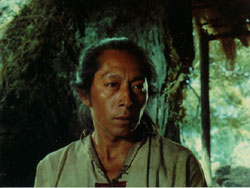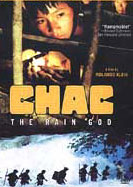FILM NOTES
FILM NOTES INDEX
NYS WRITERS INSTITUTE
HOME PAGE

(Mexico/Panama, 1975, 95 minutes, color, 35mm)
Directed by Rolando Klein
Cast:
Pablo Canche Balam . . . . . . . . . . The Diviner
Alonzo Mendez Ton . . . . . . . . . . The Cacique
Sebastian Santis . . . . . . . . . .Mute Boy
"Suspenseful. Hypnotic. The unselfconscious performances writer-director Rolando Klein has managed to elicit from his non-professional cast are as astonishing as this highly demanding film's lush, exotic beauty."
— Kevin Thomas, Los Angeles Times
The following is a review by Edward Guthmann that appeared in the San Francisco Chronicle, July 7, 2000:
In his first film, "Chac: The Rain God," Chilean filmmaker Rolando Klein did something remarkable. Working with nonactors in the Mexican state of Chiapas, he created a mystical adventure about a drought-stricken village that seeks a diviner (or witch doctor) to conjure rain.
Shot in 1974 and first screened here in January 1977, "Chac" was the result of Klein's fascination with the Popol Vuh, the sacred book of the Mayan Quiche Indians. After studying filmmaking at UCLA, he lived two years among the Tzeltal villagers in Chiapas, Mexico - and then recruited those villagers to act in his ambitious film. Their performances are wonderfully simple and free of "acting." Pablo Canche Balam plays the diviner, Alonzo Mendez Ton is the aggressive village leader who lacks faith in ancient ritual and Sebastian Santis plays a young boy, born mute "to keep God's secrets," who bonds with the diviner.
Despite a troubled shoot with a series of physical challenges - Klein shot a group of men walking across a waterfall - he created a lovely film with a serene, timeless quality. "Chac" reveals a culture untouched by Western commercialism and seems, in turn, to borrow nothing from conventional Hollywood filmmaking. After its initial release, "Chac" disappeared when its distributor went bankrupt. The new, restored print is particularly kind to the magical, beautifully composed images of Alex Phillips Jr. and William Kaplan Jr.
The following is a brief review by Wesley Morris that appeared in the San Francisco Examiner, July 7, 2000:
A Mayan village's quest for water yields a cascade of visual surprises in Rolando Klein's only film, "Chac, the Rain God."
Originally released in 1974, "Chac" played in a handful of cities for several weeks until its distributor went broke, and the film vanished into obscurity. (Completionists will note that the film doesn't even have a listing in the Internet Movie Database.) Milestone Films got hold of "Chac's" negative and struck a restored print that exposes the film for the organic beauty it is.
The U.S.-educated Klein made the film after an immersion in his Hispanic roots in Chiapas, Mexico, later befriending the Tzeltal Indians in a remote village, devising a script based on his time there.
The drought that plagues the village in the film precipitates an arduous faith-challenging mission to summon the Mayan rain god, a task spurred on by the village shaman. Some of the film was shot in caves, giving it a deep, thick texture that cultivates shadows, then exploits them by wedding them to ritual chants. For whom is this a greater horror? The parched Mayans, with their ongoing drought and visits by darting rays or light, or us, as we're yanked from comfort with each strange new development?
"Chac" is a relic of its mid-'70s period. The film operates with the spare-but-exaggerated flourishes of Bertolucci, Polanski, Herzog and Kubrick, protracting minimalism until it alludes to opulence. But the film is not an artistic study in atmospherics, nor is it an interrogative piece of anthropological bricolage. "Chac's" simplicity has the mythological matter-of-factness of a fable, blessed with something celestial.
The following is taken from a June 2004 review by Ian Jane that appears on the website, DVDtalk.com:
 Chac - The Rain God bears a similarity in the way that it unfolds to Werner Herzog's Aguire - The Wrath Of God, a film in which a group of conquistadors are led through the jungle by a madman played by Klaus Kinski. It also seems to pay homage to Akira Kurasawa's films (one actor, not named, was nicknamed Toshiro Mifune according to the commentary) as well as Alejandro Jodorowsky (the religious symbolism is reminiscent of part of The Holy Mountain). In short, it's a combination of symbolism and surrealism set against a simple story that allows the director/writer to bring us on a journey that examines the effects of the traditional Mayan religion and the effects that Christian colonization has had upon it. While the ways of the villagers may seem primitive at first glance, the crosses they wear around their necks and the flashlight that one of them uses in one scene confirm that modern influences have worked their way ever so subtly into their society.
Chac - The Rain God bears a similarity in the way that it unfolds to Werner Herzog's Aguire - The Wrath Of God, a film in which a group of conquistadors are led through the jungle by a madman played by Klaus Kinski. It also seems to pay homage to Akira Kurasawa's films (one actor, not named, was nicknamed Toshiro Mifune according to the commentary) as well as Alejandro Jodorowsky (the religious symbolism is reminiscent of part of The Holy Mountain). In short, it's a combination of symbolism and surrealism set against a simple story that allows the director/writer to bring us on a journey that examines the effects of the traditional Mayan religion and the effects that Christian colonization has had upon it. While the ways of the villagers may seem primitive at first glance, the crosses they wear around their necks and the flashlight that one of them uses in one scene confirm that modern influences have worked their way ever so subtly into their society.
The look of the film is quite impressive. Utilizing two cinematographers, Klein manages to capture some beautiful footage of the jungle and the surrounding area but frames it in such a way that at times, it almost feels claustrophobic and appears to be encroaching upon the villagers in a couple of scenes. The lush greens of the plant life are offset against the drab, black village and the gray and black clothing worn by its inhabitants, providing an interesting contrast both visually and symbolically. The jungle, which thrives, being obviously green, while the village, which is dying, is drab and dark looking.
Klein's decision to use real natives in the cast instead of professional actors ensured that the film retains an authentic and realistic feel, even when surrealist moments occur, such as when an owl suddenly turns into a human priest. Much of this story was taken from one of the only surviving Mayan religious texts, the Popul Vuh, so the casting of those familiar with the writing contributes further to the atmosphere that the film is able to create.
While it moves at a slow pace and may alienate some less than patient viewers, Chac - The Rain God is ultimately a thought provoking and unusual film that proves to be quite rewarding to those diligent enough to invest the time and energy to figure it out. The visuals are fantastic, the performances are interesting, and the story is original.
The following is taken from a Newsweek review that appeared at the time of the film's release, August 22, 1977:
With the exception of a midget actor from Mexico City, no one in the cast of Chac had ever appeared in a movie before; few, in fact, had ever seen a movie. Recruited in the ruggedly beautiful mountains of Chiapas, near the Mexican-Guatemalan border, the performers-naturals in the truest sense-are Tzeltal and Lancadon Indians, direct descendants of the Mayans….
Were it not for the telltale flashlight the young village leader proudly bears, Klein's story might be set in a historical no man's land. Plagued by drought, the desperate natives of a remote village enlist the aid of a mysterious diviner to bring them rain. Privy to the secrets of the ancients, the diviner leads them on a wonder-filled journey in search of water from the well of the mother of waters-which must be used in the ceremony to invoke Chac, the god of rain.
Klein's theme is the clash between modern skepticism-represented by the frightened, faithless village leader- and the mystical wisdom of the past. And before you can say Carlos Castaneda, magic wins the day. Such is the magic of cinema itself-which can transform an owl into a man, or take us for a delirious ride on the wings of a hawk-that our own skepticism is soon swept away….
For additional information, contact the Writers Institute at 518-442-5620 or online at https://www.albany.edu/writers-inst.
 Chac: The Rain God
Chac: The Rain God